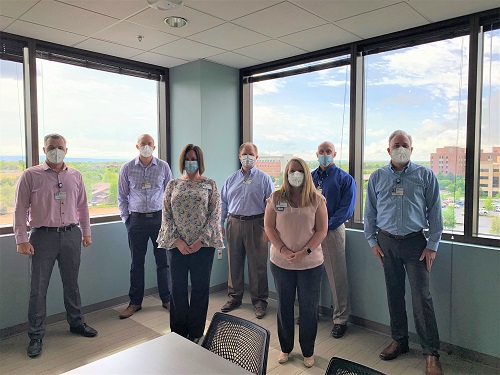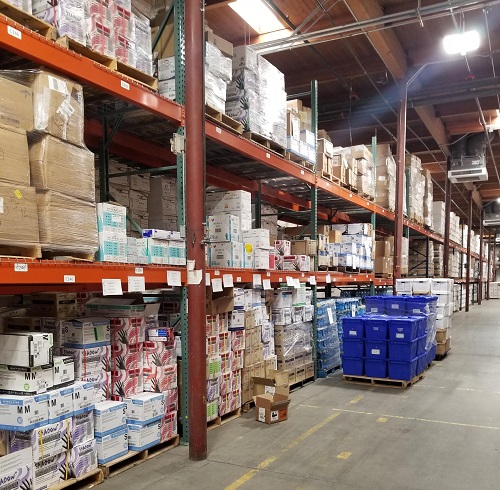St. Luke’s Health System built a war room, partnered with local businesses and doubled down on its CSC plan.
St. Luke’s, based in Boise, Idaho, serves much of Idaho and parts of eastern Oregon. It operates eight hospitals and more than 200 clinics and ranked second among the country’s medium-sized health systems by Fortune/IBM Watson Health for 2021. It’s the eighth consecutive year St. Luke’s has been in the top 15 on the prestigious list.
The recognition is consequential this year considering the work health systems were tasked with in 2020 during the height of the pandemic. Medical supply chains were relentlessly strained, but resolute health systems nationwide relied on strong cultures for problem solving as COVID cases surged.
War Room
“We built an incident command center structure for product shortages within a ‘war room’ type of setting,” said Adrian Wengert, vice president of supply chain for St. Luke’s.

It was a few months before the country felt the full effects of the pandemic when St. Luke’s noticed a lack of available N95 masks in the domestic marketplace and shortages within other PPE categories. That allowed them to get a jump on product deficits.
“We quickly reprioritized our strategic supply chain sourcing and contracting teams and began targeting PPE and other product categories,” Wengert emphasized. They placed forward and bulk buys through global direct and/or broker channels.
“We built a detailed dashboard and hardwired reporting activity through the organization to ensure transparency to stakeholders who needed to know the granularity of what was on order with inbound ETAs, what was in our possession and what was secured but not shipped,” Wengert added. This level of detail had to be shown with both pre-COVID days of inventory on hand (DOH) and post-COVID DOH as demand surge guided St. Luke’s sourcing and procurement plan.
“I’m happy to say that due to our alternate sourcing efforts, St. Luke’s and our 15,000 employees never ran out of PPE or other supply products during the pandemic and through today,” Wengert proclaimed.
The alternative sourcing stock generally had similar quality as standard supplies, according to Wengert, but feedback from physicians and clinicians was typically negative for fit, comfort and ease of use.
Due to potential supply disruptions during the pandemic, St. Luke’s will continue to use alternative source products that were purchased. But when strategic stock reserves are brought back to appropriate levels, Wengert expects employees to demand supply with better comfort and require pre-pandemic brand supply standards.
Local Businesses Shine
Creativity and ingenuity led St. Luke’s to find untapped sources of non-traditional supply. “For example, a team member remembered that tattoo parlors use gloves which led us to a national tattoo parlor distributor providing us with 1.5 million nitrile medical grade gloves,” Wengert said.
Like many health systems, St. Luke’s had success recruiting a local distillery to make hand sanitizer. “Once we secured commitments in thousand-pound vat increments, we needed to source scarce smaller plastic bottles and coordinate the filling and labeling of it,” Wengert explained.
St. Luke’s also utilized 3D printing assistance from local business for faceshields.
Alternative sourcing will continue for a limited amount of supply categories for St. Luke’s like true commodities such as nitrile exam gloves. “We expect to use a few new sales channels and delivery models that have proven to have better customer service and logistics than others,” Wengert said.
Alternative Sourcing into the Future
Manufacturing proximity, manufacturing redundancy, supply chain ownership and control, number of sources per product and strategic reserves strategy are all factors being used to determine which alternative sources St. Luke’s will use in the long term.

“Alternative sources, or self-contracting, will also be used to supplement risks from traditional sources that don’t have the capacity or willingness to commit to appropriate contractual flex terms that are absent in today’s GPO contracts,” Wengert added.
A digital marketplace isn’t currently being implemented at St. Luke’s, but Wengert said they are interested in exploring its capabilities and functionality to drive increased insight and value from a speed to execution standpoint.
“Analytics have become essential,” Wengert said. “We quickly developed analytics and IT tools to track and forecast utilization and stock on hand, and this new visibility is now ingrained in our demand forecasting.”
Consolidated Service Center Strategy
St. Luke’s had already been examining a Consolidated Service Center (CSC) strategy and the pandemic validated that direction, according to Wengert. “Short term, we’ve further optimized service levels and safety stock and have invested in the space necessary to house that stock,” he said.
The Idaho-based health system sought out sustainable ideas like reusable instrument processing bins and sharps containers and those became saving graces when both blue surgical wrap became non-existent and the plastics manufacturing plant they use to create disposable sharps containers caught fire earlier this year.
“Had we not actively and strategically sought out sustainable ideas like that, we would have been in another level of crisis entirely,” Wengert affirmed.
“Every crisis is different and requires fast decision making. Our sharpened collective skill sets are now being utilized to assess the diversification benefits of new domestic production options against the accompanying pricing pressure,” Wengert said. “We had to refocus our sourcing managers and buyers to quickly develop new relationships, new supply chains and new logistics.”
